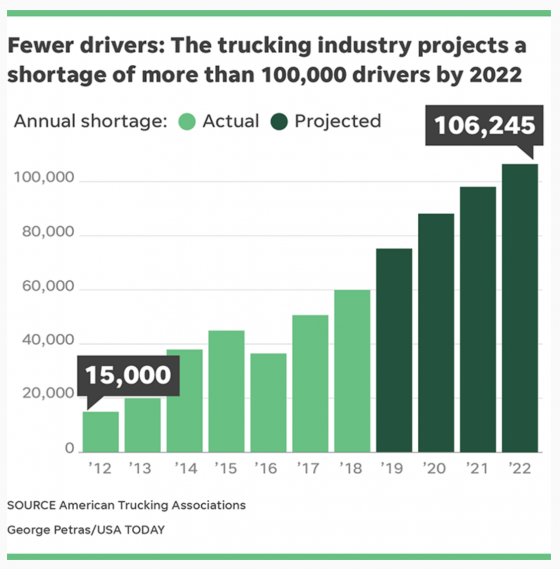Factors including electronic-logging of driver hours, a growing need for shipment of items by Amazon and a surge in retirement of baby-boomers have meant a shortage of freight truck drivers and rising shipping costs.
The American Trucking Associations reported a shortfall of 51,000 truck drivers nationwide in 2017, up from 36,500 in 2016 and 20,000 in 2013. The ATA projects the driver gap will increase to nearly 100,000 by 2021.
 “We’ve probably never had a situation like we have today, where the demand is strong and capacity is constrained,” Bob Costello, chief economist of the American Trucking Associations (ATA), a trade group representing trucking companies told USA Today. The ATA also reported that transportation companies are taking steps to attract drivers, such as pay increases and signing bonuses.
“We’ve probably never had a situation like we have today, where the demand is strong and capacity is constrained,” Bob Costello, chief economist of the American Trucking Associations (ATA), a trade group representing trucking companies told USA Today. The ATA also reported that transportation companies are taking steps to attract drivers, such as pay increases and signing bonuses.
Ben Cubitt, senior vice president of Transplace, a freight management firm noted that 99% of trucks nationwide are in use, up from 92% in October 2015. “Every truck is spoken for every day,” he said, adding that trucking companies have increased rates 6% to 10% in contracts with shippers over the past year to offset higher wages and take advantage of the strong demand. Trucks account for almost two-thirds of all tonnage moved in the U.S., according to the American Trucking Associations.
A new federal mandate for electronic logging devices that took effect in December, limiting the number of hours drivers can work, has had a big impact. These devices now take into account all time spent on the road, even waiting for cargo to be taken off a truck, which can cause hours to add up quickly and push a driver past the legal limit of consecutive work hours.
“There is a lot of uncertainty within the trucking world right now about what the effects of the [electronic logging devices] mandate’s going to be in the long term,” Steve Viscelli, a sociology professor at the University of Pennsylvania told USA Today. He added that E-commerce also has had a “huge effect.”
Price increases passed on to consumers are low so far, but are expected to increase as the driver shortage continues.
